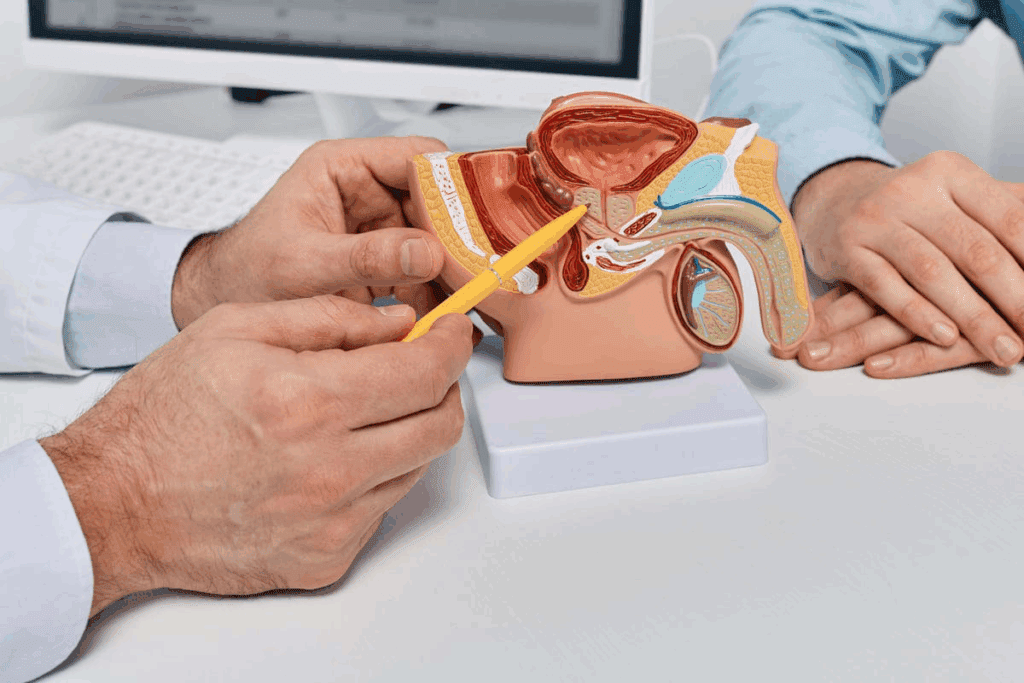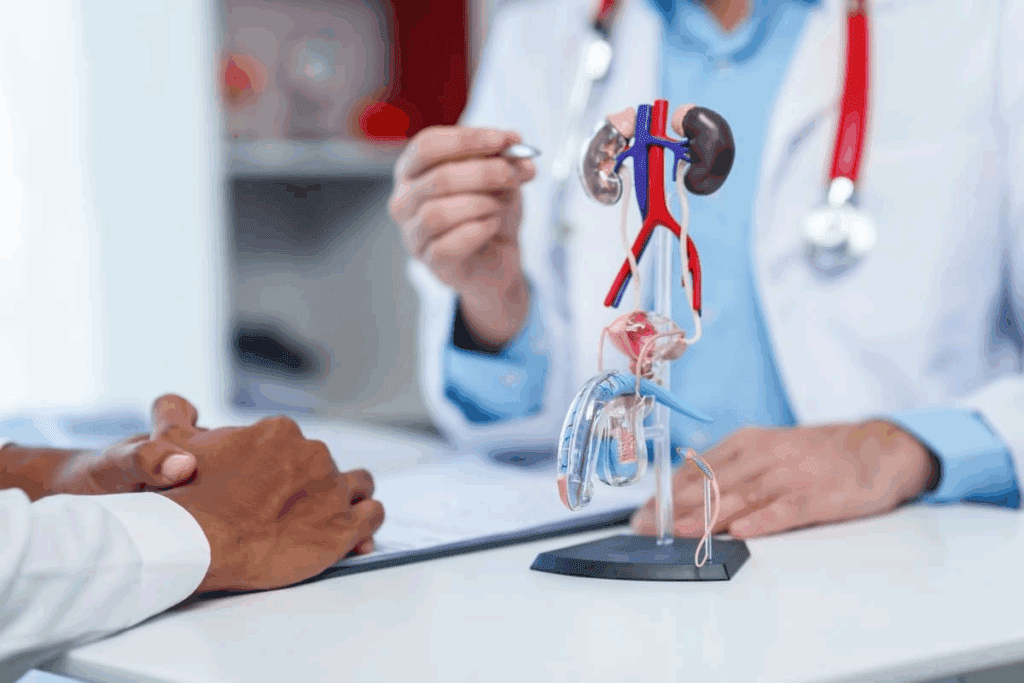
Asymptomatic bacteriuria is when bacteria live in the urinary tract without causing any discomfort. It’s more common than you might think. Studies show that up to 45% of people with a vagina and up to 50% of those over 70 in long-term care have bacteria in their urine without symptoms.
We dive into this condition and its effects. We ask if urinary tract infections can heal on their own. Knowing about asymptomatic bacteriuria helps us make better health choices.

It’s important to know about bladder infections to spot their signs and get the right treatment. These infections are a big health issue, hitting millions globally. We’ll look into what bladder infections are, their usual symptoms, and how they’re different from other UTIs.Can you have a bladder infection without symptoms? Learn about asymptomatic bacteriuria and when treatment is necessary.
A bladder infection, or cystitis, happens when bacteria get into the bladder through the urethra and cause an infection. The most common bacteria causing bladder infections is Escherichia coli (E. coli). This infection is a lower urinary tract infection (UTI) and can lead to various symptoms.
The symptoms of a bladder infection can vary but usually include:
Not everyone will have all these symptoms, and some might have others. Spotting these signs is key to getting medical help.
UTIs and bladder infections are often used the same way but are not exactly the same. A UTI is a broader term for any infection in the urinary tract, including the kidneys, bladder, ureters, and urethra. A bladder infection is a specific UTI that happens when the infection is in the bladder.
The main differences are in where the infection is and sometimes how severe it is. Knowing these differences is important for the right diagnosis and treatment.

Bladder infections can sometimes be silent. This raises the question: can you have a bladder infection without symptoms? This is known as asymptomatic bacteriuria. It’s when bacteria are in the urine but you don’t show typical UTI symptoms.
Asymptomatic bacteriuria means bacteria are in your urine but you don’t feel sick. It’s different from UTIs, where you might feel pain or discomfort.
To find out if you have it, doctors use urine culture tests. But just finding bacteria doesn’t mean you need treatment.
Silent bladder infections are common in some groups. Older adults, like those in nursing homes, are more likely to have them. People with diabetes or those using urinary catheters also face a higher risk.
How common it is varies by group. For example, up to 50% of elderly women in nursing homes might have it.
Why some infections don’t show symptoms is not fully understood. But several things might play a role. These include the type of bacteria, how well your immune system works, and any health conditions you might have.
Some bacteria might not be as bad, leading to fewer symptoms. Others might have a stronger immune system, keeping symptoms away.
Who Is Most Likely to Have Asymptomatic Bladder Infections?
Knowing who is at risk for asymptomatic bladder infections is key for good health care. These infections can happen to many people. But some groups face a higher risk because of certain factors.
Several things can increase the chance of getting asymptomatic bacteriuria. These include age, gender, health conditions, and medical procedures.
Asymptomatic bacteriuria is more common in some groups. For example, pregnant women are a big concern because of the risks of untreated infections.
Demographic Group | Prevalence of Asymptomatic Bacteriuria |
Pregnant Women | 2-10% |
Older Adults (>65 years) | 15-50% |
Diabetic Patients | 10-20% |
Patients with Indwelling Catheters | 50-100% |
This shows why it’s important to focus on screening and managing these groups.
Some groups face a higher risk of asymptomatic bacteriuria. This is because of weaker immune systems, body differences, and health issues.
Pregnant women are at higher risk because of changes in their body that can lead to UTIs. Older adults have weaker immunity and more health problems, making them more likely to get infections.
It’s vital for healthcare providers to understand these risks and variations. This helps them to spot and treat asymptomatic bacteriuria effectively.
UTIs can show up in different ways, making them tricky to spot. While many know about the usual signs like burning while peeing, some UTIs are not so obvious.
Typically, UTIs cause a burning feeling when you pee. But, some people might not feel this burning. Instead, they might feel uncomfortable in a more general way.
Spotting a UTI without burning requires knowing other signs. These can include feeling tired or having stomach pain.
Some folks with UTIs feel pressure in their pelvis but no pain. This can be a sign that’s easy to miss.
It’s important to remember that UTIs can show up differently for everyone. Things like age, health, and the type of bacteria can change how symptoms appear.
Not everyone with UTIs feels the need to pee a lot or often. Some might just feel tired or not quite right.
To spot UTIs with subtle signs, pay attention to any changes in how you pee or feel. Knowing your risk factors is also key.
Subtle Symptoms | Possible Indications |
General malaise | Possible UTI, specially in elderly or immunocompromised individuals |
Pelvic pressure | Could indicate a UTI, specially if accompanied by other urinary symptoms |
Fatigue | May be a sign of infection, including UTIs, specially if persistent or severe |
By knowing these subtle signs and the factors that affect UTI symptoms, we can better find and treat UTIs. Even when they don’t show up like usual.
Asymptomatic bladder infections are found with a simple urine test. These tests look for bacteria in the urine, even when you don’t feel sick.
Routine urine tests are key for finding asymptomatic bacteriuria. Doctors might do a urinalysis during a check-up. They look for bacteria, white blood cells, or other signs of infection.
Urine tests show important signs of infection:
Doctors test for asymptomatic bacteriuria during routine check-ups. They do this more often in people at higher risk, like pregnant women or those with diabetes. They also test when looking at other health issues that might be linked to UTIs.
It’s hard to tell if it’s contamination or infection in asymptomatic bacteriuria. Contamination happens when bacteria from the genital area get into the urine sample. To avoid this, doctors usually take a midstream urine sample.
Here’s how to tell the difference:
Knowing how to find asymptomatic bladder infections is key for right diagnosis and care. Drinking more water and peeing can help with UTI symptoms. But, it’s not a replacement for medical tests and treatment when needed.
It’s important to understand the connection between asymptomatic and symptomatic urinary tract infections (UTIs). Asymptomatic bacteriuria is when bacteria are in the urine but don’t cause symptoms. Sometimes, this can turn into a symptomatic UTI.
Yes, asymptomatic infections can turn into symptomatic UTIs under certain conditions. Studies show that people with asymptomatic bacteriuria might start showing symptoms if their health changes or if they have medical procedures.
Several factors can make symptoms appear in people with asymptomatic bacteriuria. These include:
Knowing these factors is key for catching UTIs early and treating them.
The way bladder infections progress can differ from person to person. Some cases of asymptomatic bacteriuria might clear up on their own. But others might turn into symptomatic UTIs or even more serious infections like pyelonephritis.
The length of time asymptomatic bacteriuria lasts can vary a lot. It might go away on its own, or it could stick around for months or years. Keeping an eye on it and following up is important to figure out the best next steps.
When dealing with asymptomatic bacteriuria, we need to look at the person’s overall health, risk factors, and any underlying conditions.
Some urinary tract infections might clear up by themselves. But others need medical help. Whether a UTI goes away on its own depends on several things. These include the body’s defenses and how serious the infection is.
The body has ways to fight off infections, like UTIs. The urinary tract has defenses to keep bacteria out. For example, urine flow helps wash out bacteria. The cells lining the urinary tract also make substances that kill bacteria.
How long it takes for a UTI to clear up can vary a lot. Some people might see symptoms go away in a few days. But for others, the infection might stick around if not treated.
Drinking more water is often suggested to help with UTIs. It can help flush out bacteria from the urinary tract. This might help the infection clear up faster.
Not treating a UTI can lead to serious problems. This is true for pregnant women, the elderly, and those with weak immune systems. Untreated UTIs can turn into more serious infections. These can even be life-threatening, like sepsis.
Knowing when to treat asymptomatic bladder infections is key for good care. Asymptomatic bacteriuria is when bacteria are found in urine without symptoms. It’s found through urine tests. Whether to treat it depends on the patient’s health, risk factors, and medical guidelines.
Pregnant women should be treated because UTIs can cause serious problems like pyelonephritis. This can lead to preterm labor. Pregnant women are more at risk from UTIs, so treating them quickly is important. Also, people having urological procedures or with certain health issues might need treatment to avoid complications.
“The presence of bacteriuria in pregnant women is associated with an increased risk of preterm birth and other complications, highlighting the importance of screening and treatment.”
For most people who aren’t pregnant and don’t have other health issues, treatment isn’t needed. Using antibiotics can lead to antibiotic resistance and side effects. Instead, doctors might just watch the condition and treat any underlying issues that could lead to UTIs.
Guidelines say to screen and treat only certain groups, like pregnant women and those having specific urological procedures. They stress the need to avoid unnecessary antibiotics to fight antibiotic resistance. We follow these guidelines to give our patients the best care based on the latest research.
Sometimes, the body can fight off UTIs without antibiotics, if the immune system is strong and the infection isn’t severe. Drinking more water and other supportive actions can help symptoms and aid in healing. But, it’s important to talk to a doctor to figure out the best plan for each person.
Pregnant women with asymptomatic bacteriuria face higher risks. It’s vital to screen them early. Pregnancy changes the body, affecting the urinary tract. We’ll look at the risks, screening, and treatment for pregnant women.
Asymptomatic bacteriuria can cause serious issues in pregnant women. These include pyelonephritis, preterm labor, and low birth weight. Pregnancy changes the urinary tract, making infections more likely.
Screening for asymptomatic bacteriuria starts at the first prenatal visit. The American College of Obstetricians and Gynecologists suggests screening between 12 and 16 weeks. A urine culture is the main test used.
Antibiotics are often prescribed for pregnant women with asymptomatic bacteriuria. The chosen antibiotic must be safe for both mother and fetus. Amoxicillin and nitrofurantoin are common choices.
Antibiotic | Dosage | Duration |
Amoxicillin | 500 mg | 3-7 days |
Nitrofurantoin | 100 mg | 5-7 days |
We’ve discussed the special needs for pregnant women with asymptomatic bacteriuria. This includes the risks and how to screen and treat them. Understanding these helps healthcare providers give the best care.
It’s important to know how UTIs and sexual activity are linked. We’ll look at how sex can raise UTI risks and how to avoid them.
Sex can make UTIs more likely, mainly for women. Bacteria from sex can get into the urinary tract and cause infections. We’ll talk about how this happens and why it’s a risk.
Factors Contributing to UTI Risk During Sexual Activity:
While UTIs aren’t usually seen as STDs, men can pass bacteria to their partners. We’ll look at the facts and how likely this is.
UTIs aren’t STDs, but sex can play a part in getting them. We’ll explain the difference and what it means for treatment.
Sexually active people can lower UTI risks. We suggest peeing after sex, staying clean, and trying certain foods or supplements.
Knowing the link between UTIs and sex helps protect urinary health. We suggest talking to doctors for specific advice on preventing and treating UTIs.
Understanding asymptomatic bacteriuria is key to keeping your bladder healthy. We’ve looked into how bladder infections work, even when you don’t feel sick. Pregnant women, for example, face a higher risk and need extra care.
To keep your bladder in good shape, know the risks and take action. It’s important to know when a UTI might clear up on its own. But also, watch for signs that you might need to see a doctor, even if you’re not feeling pain.
Regular health checks and screenings are vital. They help catch problems early, so you can get the right treatment fast.
By staying informed and careful, you can protect your bladder health. We stress the need for awareness and prevention. This helps lower the risk of UTI complications, even when symptoms are not obvious.
Sometimes, a UTI might clear up by itself. But, it’s not always the case. Untreated UTIs can lead to serious problems. We suggest getting medical help if symptoms don’t go away.
Yes, it’s possible to have a UTI without feeling pain or burning. Some people might not notice any symptoms at all.
No, UTIs are not sexually transmitted diseases. But, sex can make you more likely to get a UTI.
While direct transmission is rare, sex with someone who has bacteria can increase a woman’s risk of UTI. This is because bacteria can be introduced into the urinary tract.
Drinking more water and peeing can help flush out bacteria. This might help treat a UTI. But, if symptoms don’t improve, you should see a doctor.
Sometimes, the body can fight off a UTI without antibiotics. But, antibiotics are usually needed to treat UTIs effectively.
No, not all UTIs cause pain. Some people might not feel any discomfort or might only have mild symptoms.
Yes, it’s possible to have a UTI without feeling the need to urinate often or urgently. Some people might not notice any symptoms at all.
Sometimes, a UTI can clear up on its own. But, it’s not always the case. We advise getting medical help to avoid complications.
Yes, sometimes, asymptomatic bacteriuria can clear up by itself. But, in some cases, like in pregnant women, treatment is needed to prevent problems.
Yes, it’s possible to have a UTI without feeling a burning sensation. Some people might not notice any symptoms at all.
In some cases, UTIs can clear up by themselves. But, it’s not always the case. We recommend getting medical help if symptoms don’t go away to prevent complications.
Subscribe to our e-newsletter to stay informed about the latest innovations in the world of health and exclusive offers!
WhatsApp us